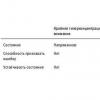Flemoxin Solutab 500 application. Flemoxin Solutab: instructions for use for adults and children. Flemoxin Solutab has contraindications
APPROVED BY
By order of the chairman
Medical Control Committee
And pharmaceutical activities
Ministry of Health
Republic of Kazakhstan
From "___" ____________ 20__
№____________
Instructions for medical use
Medicinal product
Flemoxin Solutab®
Flemoxin Solutab®
International non-proprietary name
Amoxicillin
Dispersible tablets 125 mg, 250 mg, 500 mg, 1000 mg
Composition
One tablet contains
active substance: amoxicillin as amoxicillin trihydrate
125 mg, 250 mg, 500 mg, 1000 mg
Excipients: dispersible cellulose, microcrystalline cellulose, crospovidone, vanillin, tangerine flavor, lemon flavor, saccharin, magnesium stearate.
Description
Tablets from white to light yellow, oval in shape with the company logo and a digital designation on one side (125 mg - "231", 250 mg - "232", 500 mg - "234", 1000 mg - "236") and risk, on the other side.
Pharmacotherapeutic group
Antimicrobial drugs for systemic use. Penicillins wide range actions.
ATX code J01СA04
Pharmacokinetics
Suction
After oral administration, amoxicillin is absorbed quickly and almost completely (about 93%), acid-resistant. Food intake has practically no effect on the absorption of the drug. The maximum concentration of the active substance in the plasma is observed after 1-2 hours. After oral administration of 500 mg of amoxicillin, the maximum concentration of the active substance, which is 5 μg / ml, is observed in the blood plasma after 2 hours. When the dose of the drug is increased or decreased by 2 times, the maximum concentration in the blood plasma also changes by 2 times.
Distribution
About 20% of amoxicillin binds to plasma proteins. Amoxicillin penetrates well into mucous membranes, bone tissue, intraocular fluid and sputum at therapeutically effective concentrations. The concentration of amoxicillin in bile exceeds its concentration in blood plasma by 2-4 times. In the amniotic fluid and umbilical cord vessels, the concentration of amoxicillin is 25-30% of its level in the blood plasma of a pregnant woman. Amoxicillin poorly penetrates the blood-brain barrier; however, with inflammation meninges concentration in cerebrospinal fluid is about 20% of the concentration in blood plasma.
Metabolism
Amoxicillin is partially metabolized in the liver, most of its metabolites have no microbiological activity.
Withdrawal
Amoxicillin is eliminated mainly by the kidneys, about 80% by tubular excretion, 20% by glomerular filtration. In the absence of impaired renal function, the half-life of amoxicillin is 1-1.5 hours. In premature infants, newborns and children under 6 months of age. - 3-4 hours
Pharmacokinetics in special clinical situations
The half-life of amoxicillin does not change with impaired liver function.
Pharmacodynamics
Flemoxin Solutab® is a bactericidal acid-resistant broad-spectrum antibiotic from the group of semi-synthetic penicillins. Active against gram-positive and gram-negative microorganisms such as Streptococcus pyogenes, Streptococcus pneumoniae, Clostridium tetani, Clostridium welchii, Neisseria gonorrhoeae, Neisseria meningitidis, Staphylococcus aureus (non-beta-lactamase producing) Helicobacter pylori... Less active against Enterococcus faecalis, Escherichia coli, Proteus mirabilis, Salmonella typhi, Shigella sonnei, Vibrio cholerae. Not active against beta-lactamase-producing microorganisms, Pseudomonas spp., Indole-positive Proteus spp., Serratia spp., Enterobacter spp.
Indications for use
Respiratory infections
Infections of the genitourinary system
Organ infections gastrointestinal tract
Skin and soft tissue infections
Method of administration and dosage
The drug is taken orally before or after a meal. The tablet can be swallowed whole, divided into parts or chewed with a glass of water, and can also be diluted in water to form a syrup (in 20 ml) or suspension (in 100 ml) with a pleasant fruity taste.
The dose is set individually, taking into account the severity of the disease, the patient's age. In the case of infectious and inflammatory diseases of mild and moderate it is recommended to use the drug according to the following scheme:
Adults and children over 10 years are prescribed 500 - 750 mg 2 times / day or 375 - 500 mg 3 times / day. Minimum single dose 375 mg, maximum daily 1500 mg.
Children from 6 to 10 years old appoint 375 mg 2 times / day or 250 mg
3 times / day The minimum single dose is 250 mg, the maximum daily dose is 750 mg.
In the treatment of severe infections and diseases such as acute otitis media, three doses are preferable.
At chronic diseases, recurrent infections and infections heavy course the dose of the drug can be increased: adults are prescribed 750 mg - 1 g 3 times / day, the minimum single dose is 750 mg, the maximum daily dose is 3 g; children 60 mg / kg / day, divided into 3 doses, the minimum single dose is 20 mg / kg, the maximum daily dose is 60 mg / kg.
In acute uncomplicated gonorrhea, 3 g of the drug is prescribed in 1 dose in combination with 1 g of probenecid.
For patients with impaired renal function with creatinine clearance below 10 ml / min, the dose of the drug is reduced to 15-50%.
In case of infections of mild to moderate severity, the drug is taken within 5-7 days. However, for infections caused by Streptococcus pyogenes, the duration of treatment should be at least 10 days.
In the treatment of chronic diseases, infections of a severe course, the dose of the drug should be determined clinical picture diseases. Reception
The drug must be continued for 48 hours after disappearance
Symptoms of the disease.
Change in taste
Nausea, vomiting, diarrhea
Erythema multiforme (Stevens-Johnson syndrome)
Very rarely
Pseudomembranous and hemorrhagic colitis
Possible
Agranulocytosis, neutropenia, thrombocytopenia, hemolytic anemia
Specific maculopapular rash
In some cases
Moderate increase in the activity of "hepatic" transaminases
Anaphylactic shock
Angioedema
Contraindications
Hypersensitivity to the drug and other beta-lactam
Antibiotics
Infectious mononucleosis and lymphocytic leukemia
Childhood up to 6 years
Bactericidal antibiotics (including aminoglycosides, cephalosporins, vancomycin, rifampicin), when taken simultaneously, have a synergistic effect. Antagonism is possible when taken with some bacteriostatic drugs (for example, chloramphenicol, sulfonamides). Simultaneous reception with estrogen-containing oral contraceptives can lead to a decrease in their effectiveness and an increase in the risk of developing acyclic bleeding. Concomitant administration with allopurinol increases the frequency of skin reactions.
special instructions
Composition and form of release
in a blister 5 pcs .; in a box 4 blisters (125, 250, 500, 1000 mg) or in a blister 7 pcs.; in a box 2 blisters (125 mg).
Description of the dosage form
Dispersible tablets from white to light yellow, oval in shape with the company logo and number designation on one side and a line dividing the tablet in half on the other side. Numerical designation: Flemoxin Solutab ® (125 mg) - "231"; Flemoxin Solutab ® (250 mg) - "232"; Flemoxin Solutab ® (500 mg) - "234"; Flemoxin Solutab ® (1000 mg) - "236".
Characteristic
Bactericidal acid-resistant broad-spectrum antibiotic from the group of semi-synthetic penicillins.
pharmachologic effect
pharmachologic effect- bactericidal, antibacterial.Pharmacodynamics
Active against gram-positive and gram-negative microorganisms such as Streptococcus pyogenes, Streptococcus pneumonia, Clostridium tetani, C.welchii, Neisseria gonorrhoeae, Neisseria meningitidis, Staphylococcus aureus (non-beta-lactamase producing), Bacillus anthracis, Listeria monocytogenteres, Helicobac. Less active in relation to Enterococcus faecalis, Escherichia coli, Proteus mirabilis, Salmonella typhi, Shigella sonnei, Vibrio cholerae. Not active against beta-lactamase-producing microorganisms, Pseudomonas spp., indole positive Proteus spp., Serratia spp., Enterobacter spp.
Pharmacokinetics
Suction
After oral administration, it is absorbed quickly and almost completely (about 93%), acid-resistant. After oral administration at a dose of 500 mg, the C max of the active substance in the plasma is 5 μg / ml and is observed in the blood plasma after 2 hours. When the dose of the drug is increased or decreased by 2 times, the C max in the blood plasma also changes by 2 times. Food intake has practically no effect on the absorption of the drug.
Distribution
Plasma protein binding is about 20%. Amoxicillin penetrates well into mucous membranes, bone tissue, intraocular fluid and sputum in therapeutically effective concentrations. The concentration of amoxicillin in bile exceeds its concentration in blood plasma by 2-4 times. In the amniotic fluid and umbilical cord vessels, the concentration of amoxicillin is 25-30% of its level in the blood plasma of a pregnant woman.
Poorly penetrates the BBB, but with inflammation of the meninges, the concentration in the cerebrospinal fluid is about 20% of the concentration in the blood plasma.
Metabolism
Partially metabolized, most of its metabolites are inactive against microorganisms.
Withdrawal
Eliminated mainly by the kidneys, about 80% by tubular excretion, 20% by glomerular filtration. In the absence of impaired renal function, T 1/2 is 1-1.5 hours. In premature babies, newborns and children under 6 months of age - 3-4 hours.
Pharmacokinetics in special clinical situations.
T 1/2 of amoxicillin does not change with impaired liver function.
In case of impaired renal function (Cl creatinine ≤15 ml / min), T 1/2 of amoxicillin can increase and reaches 8.5 hours with anuria.
Indications of the drug Flemoxin Solutab ®
Infectious and inflammatory diseases caused by microorganisms sensitive to the drug:
respiratory tract infections;
organs of the genitourinary system;
organs of the digestive tract;
skin and soft tissues.
Contraindications
Hypersensitivity to the drug and other beta-lactam antibiotics.
Carefully:
polyvalent hypersensitivity to xenobiotics;
Infectious mononucleosis;
lymphocytic leukemia;
a history of gastrointestinal diseases (especially colitis associated with the use of antibiotics);
renal failure;
pregnancy;
lactation period.
Application during pregnancy and lactation
It is possible to prescribe the drug during pregnancy and lactation if the expected positive result from the use of the drug exceeds the risk of development side effects... In small quantities, amoxicillin is excreted in breast milk, which can lead to the development of sensitization phenomena in a child.
Side effects
From the digestive tract: rarely - change in taste, nausea, vomiting, diarrhea; in some cases - a moderate increase in the activity of hepatic transaminases; extremely rare - pseudomembranous and hemorrhagic colitis.
From the urinary system: extremely rare - the development of interstitial nephritis.
From the hematopoietic system: agranulocytosis, neutropenia, thrombocytopenia, hemolytic anemia are possible, but they are also extremely rare.
Side effects from the side nervous system when using amoxicillin in dosage form, dispersible tablets are not registered.
Allergic reactions: skin reactions, mainly in the form of a specific maculopapular rash; rarely - exudative erythema multiforme (Stevens-Johnson syndrome); in some cases - anaphylactic shock, angioedema.
Interaction
Probenecid, phenylbutazone, oxyphenbutazone, to a lesser extent acetylsalicylic acid and sulfinpyrazone, inhibit the tubular secretion of penicillins, which leads to an increase in the half-life and an increase in the concentration of amoxicillin in the blood plasma. Bactericidal antibiotics (including aminoglycosides, cephalosporins, vancomycin, rifampicin), when taken simultaneously, have a synergistic effect; possible antagonism when taken with some bacteriostatic drugs (for example, chloramphenicol, sulfonamides). Concomitant use with estrogen-containing oral contraceptives can lead to a decrease in their effectiveness and an increased risk of breakthrough bleeding). Concomitant administration with allopurinol does not increase the frequency of skin reactions, in contrast to the combination of allopurinol with ampicillin.
Method of administration and dosage
Inside, before, during or after a meal. The tablet can be swallowed whole, divided into parts or chewed with a glass of water or diluted in water to form a syrup (20 ml) or suspension (100 ml).
Adults and children over 10 years of age (with infections of mild and moderate severity) - 500-750 mg 2 times a day or 375-500 mg 3 times a day.
Children from 3 to 10 years old - 375 mg 2 times a day or 250 mg 3 times a day; from 1 year to 3 years - 250 mg 2 times a day or 125 mg 3 times a day. Daily dose for children (including children under 1 year old) - 30-60 mg / kg / day, divided into 2-3 doses.
In the treatment of severe infections, as well as in infections with hard-to-reach foci (for example, acute otitis media), it is preferable to take the drug three times.
With chronic diseases, relapses, severe infections: adults - 0.75-1 g 3 times a day, children - up to 60 mg / kg / day in 3 divided doses.
In acute uncomplicated gonorrhea - 3 g, once, in combination with 1 g of probenecid.
With infections of mild and moderate severity, treatment is carried out within 5-7 days, with infections caused by Streptococcus pyogenes, - at least 10 days.
In the treatment of chronic diseases, severe infections, the dose of the drug should be determined by the clinical picture of the disease. The drug is continued for 48 hours after the disappearance of the symptoms of the disease.
For patients with Cl creatinine below 10 ml / min, the dose is reduced by 15-50%.
Overdose
Symptoms: nausea, vomiting, diarrhea, imbalance in water and electrolyte balance.
Treatment: gastric lavage, the appointment of activated charcoal, saline laxatives, correction of water and electrolyte balance.
special instructions
A history of erythroderma is not a contraindication for the appointment of Flemoxin Solutab ®.
Possible cross-resistance with drugs penicillin and cephalosporins.
As with the use of other drugs of the penicillin series, the development of superinfection is possible.
The appearance of severe diarrhea, characteristic of pseudomembranous colitis, is an indication for discontinuation of the drug.
Prescribe the drug to patients with infectious mononucleosis and lymphocytic leukemia should be used with caution, because there is a high probability of the appearance of exanthema of non-allergic genesis.
Storage conditions of the drug Flemoxin Solutab ®
At a temperature not exceeding 25 ° C.Keep out of the reach of children.
Shelf life of the drug Flemoxin Solutab ®
5 years.Do not use after the expiration date printed on the package.
Synonyms for nosological groups
| ICD-10 heading | Synonyms of diseases according to ICD-10 |
|---|---|
| A04.9 Bacterial intestinal infection unspecified | Bacterial intestinal infections |
| Gastrointestinal infections | |
| Intestinal bacterial infections | |
| Digestive tract infections | |
| Infectious and inflammatory diseases of the gastrointestinal tract | |
| Gastrointestinal tract infection | |
| Intestinal infection | |
| Intestinal infection | |
| Acute intestinal infection | |
| Acute infectious disease of the gastrointestinal tract | |
| Acute intestinal disease involving the colon | |
| J06 Acute upper infections respiratory tract multiple and unspecified localization | Bacterial Upper Respiratory Tract Infections |
| Pain with colds | |
| Pain in infectious and inflammatory diseases of the upper respiratory tract | |
| Inflammatory disease of the upper respiratory tract | |
| Inflammatory diseases of the upper respiratory tract | |
| Inflammatory diseases of the upper respiratory tract with difficult sputum discharge | |
| Secondary influenza infections | |
| Secondary infections for colds | |
| Influenza conditions | |
| Upper respiratory tract infections | |
| Upper respiratory tract infections | |
| Respiratory tract infections | |
| ENT infections | |
| Infectious and inflammatory diseases of the upper respiratory tract | |
| Infectious and inflammatory diseases of the upper respiratory tract and ENT organs | |
| Infectious and inflammatory diseases of the upper respiratory tract in adults and children | |
| Infectious and inflammatory diseases of the upper respiratory tract | |
| Respiratory tract infection | |
| Upper respiratory tract catarrh | |
| Catarrhal inflammation of the upper respiratory tract | |
| Catarrhal disease of the upper respiratory tract | |
| Catarrhal phenomena from the upper respiratory tract | |
| Cough with diseases of the upper respiratory tract | |
| Cold cough | |
| Fever with flu | |
| ARVI | |
| ARI | |
| ARI with symptoms of rhinitis | |
| Acute respiratory infection | |
| Acute infectious and inflammatory disease of the upper respiratory tract | |
| Acute colds | |
| Spicy respiratory disease | |
| Acute respiratory illness of influenza nature | |
| Sore throat or nose | |
| Cold | |
| Colds | |
| Colds | |
| Respiratory infection | |
| Respiratory Diseases | |
| Respiratory infections | |
| Recurrent respiratory tract infections | |
| Seasonal colds | |
| Seasonal colds | |
| Frequent colds viral diseases | |
| J22 Acute respiratory infection of lower respiratory tract, unspecified | Bacterial airway disease |
| Bacterial lower respiratory tract infections | |
| Bacterial Respiratory Infections | |
| Viral Respiratory Disease | |
| Viral Respiratory Tract Infections | |
| Inflammatory airway disease | |
| Difficulty sputum separation in acute and chronic respiratory diseases | |
| Respiratory tract infections | |
| Respiratory tract and lung infections | |
| Lower Respiratory Tract Infections | |
| Lower respiratory tract infections | |
| Infectious airway inflammation | |
| Respiratory tract infections | |
| Infectious lung diseases | |
| Respiratory system infectious diseases | |
| Respiratory tract infection | |
| Cold cough | |
| Pulmonary infection | |
| Acute respiratory tract infection | |
| Acute respiratory viral infection | |
| Acute inflammatory airway disease | |
| Acute airway disease | |
| Respiratory infection | |
| Respiratory viral infections | |
| Respiratory syncytial viral infection in young children | |
| Respiratory Diseases | |
| Respiratory infections | |
| L08.9 Local infection of skin and subcutaneous tissue, unspecified | Soft tissue abscess |
| Bacterial or fungal skin infection | |
| Bacterial skin infections | |
| Bacterial soft tissue infections | |
| Bacterial skin infections | |
| Bacterial skin lesions | |
| Viral skin infection | |
| Viral skin infections | |
| Inflammation of the fiber | |
| Inflammation of the skin at the injection sites | |
| Inflammatory skin diseases | |
| Pustular skin disease | |
| Pustular skin diseases | |
| Purulent-inflammatory disease of the skin and soft tissues | |
| Purulent-inflammatory skin diseases | |
| Purulent-inflammatory diseases of the skin and its appendages | |
| Purulent-inflammatory diseases of soft tissues | |
| Purulent skin infections | |
| Purulent soft tissue infections | |
| Skin infections | |
| Infections of the skin and skin structures | |
| Skin infection | |
| Infectious skin diseases | |
| Skin infection | |
| Infection of the skin and its appendages | |
| Infection of the skin and subcutaneous structures | |
| Infection of the skin and mucous membranes | |
| Skin infection | |
| Skin bacterial infections | |
| Necrotizing subcutaneous infections | |
| Uncomplicated skin infections | |
| Uncomplicated soft tissue infections | |
| Superficial skin erosion with secondary infection | |
| Umbilical infection | |
| Mixed skin infections | |
| Specific infectious processes in the skin | |
| Superinfection of the skin | |
| M60.0 Infectious myositis | Muscle abscess |
| Soft tissue infections | |
| Infectious myositis | |
| Pyomyositis | |
| Specific infectious processes in soft tissues | |
| M65 Synovitis and tendosynovitis | Inflammatory soft tissue disease |
| Nonspecific tendosynovitis | |
| Acute tenosynovitis | |
| Edematous syndrome in musculoskeletal diseases | |
| Tenosynovitis | |
| Tenosynovitis (tenovaginitis) | |
| Tendosynovitis | |
| Tenosynovitis (tenosynovitis) | |
| Tenosynovitis | |
| M65.0 Abscess of tendon sheath | Soft tissue infections |
| M71.0 Abscess of bursa | Soft tissue infections |
| M71.1 Other infectious bursitis | Bacterial bursitis |
| Infectious bursitis | |
| Soft tissue infections | |
| N39.0 Infection urinary tract no localization installed | Asymptomatic bacteriuria |
| Bacterial urinary tract infections | |
| Bacterial infections urinary tract | |
| Bacterial infections of the genitourinary system | |
| Bacteriuria | |
| Bacteriuria, asymptomatic | |
| Chronic latent bacteriuria | |
| Asymptomatic bacteriuria | |
| Asymptomatic massive bacteriuria | |
| Inflammatory urinary tract disease | |
| Inflammatory disease of the genitourinary tract | |
| Inflammatory diseases Bladder and urinary tract | |
| Inflammatory diseases of the urinary system | |
| Inflammatory diseases of the urinary tract | |
| Inflammatory diseases of the urogenital system | |
| Fungal diseases of the urogenital tract | |
| Fungal infections of the urinary tract | |
| Urinary tract infections | |
| Urinary tract infections | |
| Urinary tract infections | |
| Urinary tract infections | |
| Urinary tract infections | |
| Urinary tract infections caused by enterococci or mixed flora | |
| Uncomplicated urinary tract infections | |
| Complicated urinary tract infections | |
| Infections of the genitourinary system | |
| Urogenital infections | |
| Urinary tract infections | |
| Urinary tract infection | |
| Urinary tract infection | |
| Urinary tract infection | |
| Urinary tract infection | |
| Urinary tract infection | |
| Urogenital tract infection | |
| Uncomplicated urinary tract infections | |
| Uncomplicated urinary tract infections | |
| Uncomplicated urinary tract infections | |
| Exacerbation of a chronic urinary tract infection | |
| Retrograde kidney infection | |
| Recurrent urinary tract infections | |
| Recurrent urinary tract infections | |
| Recurrent urinary tract infections | |
| Mixed urethral infections | |
| Urogenital infection | |
| Urogenital infectious and inflammatory disease | |
| Urogenital mycoplasmosis | |
| Urological disease of infectious etiology | |
| Chronic urinary tract infection | |
| Chronic pelvic inflammatory disease | |
| Chronic urinary tract infections | |
| Chronic infectious diseases of the urinary system |
Flemoxin Solutab is an antibacterial, bactericidal drug. Instructions for use for children and adults recommends taking tablets of 500, 1000, 125 and 250 mg for the treatment of infectious and inflammatory diseases caused by microorganisms sensitive to the action of amoxicillin: infections of the skin and soft tissues; infections of the digestive, respiratory and genitourinary systems. Reviews of patients and doctors confirm that this drug helps in the treatment of angina, sinusitis and other infections in adults and children.
Release form and composition
The dosage form of the antibiotic Flemoxin Solutab is dispersible tablets 125, 250, 500 or 1000 mg. It is sold in blisters of 5 or 7 pcs.
Active ingredient: amoxicillin - 125, 250, 500 or 1000 mg (in the form of amoxicillin trihydrate).
pharmachologic effect
Flemoxin Solutab is an antibiotic of a group of semi-synthetic penicillins with a broad spectrum of action. It is a 4-hydroxyl analogue of ampicillin. Has a bactericidal effect.
Active against aerobic gram-positive and gram-negative bacteria. microorganisms producing penicillinase are resistant to amoxicillin, the active substance of the drug Flemoxin Solutab. Instructions for use for children and adults indicate that in combination with metronidazole, the antibiotic is active against Helicobacter pylori. It is believed that amoxicillin inhibits the development of resistance of Helicobacter pylori to metronidazole.
Cross-resistance exists between amoxicillin and ampicillin. The spectrum of antibacterial action expands with the simultaneous use of amoxicillin and a beta-lactamase inhibitor clavulanic acid.
This combination increases the activity of Flemoxin Solutab against Bacteroides spp., Legionella spp., Nocardia spp., Pseudomonas (Burkholderia) pseudomallei. However, Pseudomonas aeruginosa, Serratia marcescens, and many other gram-negative bacteria remain resistant.
What does Flemoxin Solutab help from?
Indications for use of the medication include infections:
- respiratory organs;
- soft tissues and skin;
- organs of the gastrointestinal tract;
- genitourinary system.
Instructions for use
Flemoxin Solutab is intended exclusively for oral administration... The tablets should be taken before, during or after meals. They can be swallowed whole, chewed with a glass of plain water, or divided into parts. You can also dilute the tablet in water to form a suspension (in 100 ml) or syrup (in 20 ml) with a pleasant fruity taste.
The dosage regimen of Flemoxin Solutaba is set individually for each patient. This takes into account the severity of the course of the disease, the sensitivity of the pathogen to the drug, the age of the patient.
In case of infectious and inflammatory pathologies of moderate and mild severity, it is advisable to use tablets according to the following scheme: 
- children aged 1 to 3 years, 250 mg of the drug 2 times a day or 125 mg 3 times a day;
- children aged 3 to 10 years, 375 mg with a frequency of 2 times a day or 250 mg 3 times a day;
- children over 10 years old and adult patients are prescribed 500-750 mg of the drug 2 times a day or 375-500 mg with a frequency of 3 times a day.
The total daily dose of the drug for children (including for children under 1 year old) should be 30-60 mg / kg of body weight per day, divided into 2-3 doses.
Instructions for the treatment of diseases
- When treating severe infectious diseases, as well as in case of hard-to-reach foci of infection (for example, acute otitis media), three doses of the drug are required.
- In acute uncomplicated gonorrhea, the patient is prescribed 3 g of Flemoxin Solutaba in 1 dose (simultaneously with 1 g of probenecid).
- Patients with functional impairment kidney with CC less than 10 ml / min, the dose of the drug is reduced by 15-50%.
- At chronic diseases, severe infections and recurrent infections, adults are prescribed 0.75-1 g 3 times a day, and children - 60 mg / kg of body weight per day (divided into 3 doses).
- In the case of infections of moderate and mild severity, Flemoxin Solutab is taken for 5-7 days. However, for infections provoked by Streptococcus pyogenes, the duration of therapy should be at least 10 days.
Taking pills is required to continue within 48 hours after the disappearance of signs of the disease.
Contraindications
- pregnancy;
- lactation;
- hypersensitivity to amoxicillin;
- lymphocytic leukemia;
- breastfeeding period;
- renal failure;
- history of gastrointestinal tract pathology (especially colitis associated with the use of antibiotics);
- Infectious mononucleosis;
- polyvalent hypersensitivity to chemicals foreign to the body (xenobiotics).
Side effects

Children, during pregnancy and breastfeeding
The use of the drug Flemoxin Solutab during pregnancy and lactation is possible if the expected benefit of therapy for the mother outweighs the risk of side effects in the fetus and infant... In small quantities, amoxicillin is excreted in breast milk, which can lead to the development of sensitization phenomena in an infant.
It is used in children according to indications according to the dosage regimen (including infants and newborns).
special instructions
Due to the high likelihood of developing exanthema with a non-allergic etiology, with infectious mononucleosis, lymphocytic leukemia, Flemoxin Solutab is prescribed with caution.
With mild diarrhea that appears during the period of taking the drug, antidiarrheal drugs that lower intestinal motility should not be used. The presence of erythroderma in the anamnestic data is not a contraindication for the appointment of therapy.
Due to the growth of microflora insensitive to the action of Flemoxin Solutab, superinfection may develop (it will be necessary to make appropriate changes to antibiotic therapy).
Drug interactions
Probenecid, phenylbutazone, oxyphenbutazone, diuretics, allopurinol, NSAIDs, to a lesser extent acetylsalicylic acid and sulfinpyrazone suppress the tubular secretion of penicillins, which leads to an increase in T1 / 2 and an increase in the concentration of amoxicillin in the blood plasma.
Bactericidal antibiotics (including aminoglycosides, cephalosporins, vancomycin, rifampicin) show synergy when taken simultaneously. Antagonism is possible when taken with some bacteriostatic drugs (for example, chloramphenicol, sulfonamides).
Analogues of the drug Flemoxin Solutab
Compositional analogs include:
- Ospamox.
- Amosin.
- Amoxicillin ratiopharm.
- Danemox.
- Grunamox.
- Amoxicillin sodium is sterile.
- Gonoform.
- Ecobol.
- Amoxisar.
- Amoxicillin DS.
- Hikontsil.
- Amoxicillin.
- Amoxicillin trihydrate.
- Amoxicillin Sandoz.
Vacation conditions and price
The average price of Flemoxin Solutab in Moscow is 307 rubles. In Kiev, you can buy an antibiotic for 119 hryvnia, in Kazakhstan - for 1266 tenge. In Minsk, pharmacies offer tablets for 7-9 BYN. rubles. Dispensed from pharmacies with a prescription.
Post Views: 1 225
Composition
active substance: amoxicillin
1 tablet contains amoxicillin (in the form of amoxicillin trihydrate) - 125 mg, 250 mg,
500 mg, 1000 mg
Excipients: microcrystalline cellulose, dispersed cellulose, crospovidone, vanillin, mandarin flavor, lemon flavor, saccharin, magnesium stearate.
Dosage form
The tablets are dispersed.
Basic physical and chemical properties: tablets of white or almost white color (during storage a light yellow tint is possible), oblong with gravings "231" for Flemoxin Solutab ® 125 mg, "232" - for Flemoxin Solutab ® 250 mg, "234" - for Flemoxin Solutab ® 500 mg , "236" - for Flemoxin Solutab ® 1000 mg, with a sign on one side and a notch on the other side.
Pharmacological group"type =" checkbox ">
Pharmacological group
Antimicrobial agents for systemic use. Beta-lactam antibiotics. Broad-spectrum penicillins. Amoxicillin. ATC code J01CA04.
Pharmacological properties
Pharmacological. Flemoxin Solutab ® is a broad-spectrum bactericidal antibiotic of the group of semi-synthetic penicillins.
In vitro data on the sensitivity of some clinically significant microorganisms to amoxicillin.
|
Activity in vitro |
Mean Minimum Inhibitory Concentration (MIS) |
||
|
0.01 - 0.1 μg / ml |
0.1 - 1 μg / ml |
1 - 10 μg / ml |
|
|
Gram-positive microorganisms |
Streptococci group A Streptococci group B Str. pneumonie, Cl.welchii Cl. tetani |
Staph. aureus ( beta-lactamase-negative strains ) B. anthracis L.subtilis L. monocytogenes |
Str. faecalis |
|
Gram-negative microorganisms |
N. gonorrhoeae N. meningitidis |
H. influenzae Bordetella pertussis |
E. coli P. mirabilis S. typhi Sh. sonnei V. cholerae. |
Amoxicillin is inactive to microorganisms that produce beta-lactamases, such as Pseudomonas, Klebsiella, indole-positive Proteus strains and strains Enterobacter. The level of resistance of susceptible microorganisms can be variable in different territories.
Pharmacokinetics.
Suction. After taking the tablets "Flemoxin Solutab ®" amoxicillin is absorbed quickly and almost completely (85 - 90%), the drug is acid-resistant. Food intake has practically no effect on the absorption of the drug. The maximum concentration in blood plasma when taking the tablets "Flemoxin Solutab ®" is achieved in 1-2 hours. After oral administration of 375 mg of amoxicillin in the blood plasma, the maximum concentration of the active substance was recorded, which is 6 μg / ml. When the dose of the drug is doubled (or reduced by 2 times), the maximum concentration in the blood plasma also changes (increases or decreases) by 2 times.
Distribution. Approximately 20% of amoxicillin binds to blood plasma proteins. Amoxicillin penetrates into mucous membranes, bone tissue and intraocular fluid, sputum in therapeutically effective concentrations. The concentration of the drug in bile exceeds its concentration in the blood by 2-4 times. In the amniotic fluid and umbilical vessels, the concentration of the drug is 25-30% of its level in the blood plasma of a pregnant woman. Amoxicillin poorly penetrates into the cerebrospinal fluid; however, with inflammation of the meninges (for example, with meningitis), the concentration in the cerebrospinal fluid is approximately 20% of the concentration in the blood plasma.
Metabolism. Amoxicillin is partially metabolized, most of its metabolites are inactive against microorganisms, but have allergenic properties.
Output. Amoxicillin is excreted mainly by the kidneys, about 80% by tubular excretion, 20% by glomerular extraction. Approximately 90% of amoxicillin is excreted after 8:00, 60-70% unchanged by the kidneys. In the absence of renal dysfunction, the half-life of the drug is 1-1.5 hours. In premature babies, newborns and infants up to 6 months - 3 - 4:00.
In case of impaired renal function (creatinine clearance is equal to or less than 15 ml / min), the half-life of the drug increases and reaches 8.5 hours with anuria.
The half-life of the drug does not change with impaired liver function.
Indications
Infections caused by microorganisms sensitive to the drug:
- respiratory organs;
- organs of the genitourinary system;
- organs of the gastrointestinal tract (GIT)
- skin and soft tissues.
Contraindications
Hypersensitivity to amoxicillin or other beta-lactam antibiotics (penicillins and cephalosporins), as well as to any of the excipients of the drug.
Interaction with other medicinal products and other types of interactions
With the simultaneous use of allopurinol and amoxicillin, the risk of skin allergic reactions may increase.
Individual cases of an increase in the level of the international normalized ratio (INR) in patients who simultaneously took amoxicillin and acenocoumarol or warfarin are described. If such use is necessary, prothrombin time or INR should be carefully monitored with the addition or discontinuation of amoxicillin treatment. In addition, dose adjustment of oral anticoagulants may be required.
Penicillins can reduce the excretion of methotrexate, which can lead to an increase in the toxicity of the latter.
When treating with amoxicillin, non-enzymatic reactions with glucose oxidase should be used to determine the level of glucose in urine, since non-enzymatic methods can give false positive results.
Probenecid, phenylbutazone, oxyphenbutazone, and to a lesser extent acetylsalicylic acid and sulfinpyrazone, suppress the tubular secretion of penicillin drugs, which leads to an increase in the half-life and drug concentration in the blood plasma.
Like other antibiotics, amoxicillin can affect the intestinal flora, which leads to a decrease in estrogen reabsorption and a decrease in the effectiveness of combined oral contraceptives.
Drugs with bacteriostatic function (tetracycline antibiotics, macrolides, chloramphenicol) can neutralize the bactericidal effect of amoxicillin. The simultaneous use of aminoglycosides is possible (synergistic effect).
Application features
Hypersensitivity.
Before starting treatment with amoxicillin, it is necessary to accurately determine the presence of a history of hypersensitivity reactions to penicillins, cephalosporins or other allergens.
Serious and sometimes even fatal cases of hypersensitivity (anaphylactoid reactions) are observed in patients during penicillin therapy. Such reactions are more likely to occur in patients with a history of hypersensitivity to penicillins or hypersensitivity to various allergens. In the event of an allergic reaction, therapy with amoxicillin should be discontinued and appropriate treatment prescribed.
Infectious mononucleosis.
Patients with infectious mononucleosis or lymphatic leukemoid reactions often (in 60-100% of cases) have a rash that is not a consequence of hypersensitivity to penicillins. Therefore, antibiotics of the ampicillin class should not be used in patients with mononucleosis.
Cross-resistance. There may be cross-hypersensitivity and cross-resistance between penicillins and cephalosporins.
Resistance.
Long-term use of the drug can cause excessive growth of microflora insensitive to the drug. As with other broad-spectrum penicillins, superinfections can occur.
Pseudomembranous colitis.
When applied to almost all antibacterial drugs including amoxicillin, antibiotic-associated colitis has been reported from mild to life-threatening. If antibiotic-associated colitis occurs, appropriate measures should be taken. Should also accept necessary measures in the event of hemorrhagic colitis or hypersensitivity reactions.
Renal failure
In patients with renal insufficiency, excretion of amoxicillin may decrease depending on the degree renal failure... In severe renal failure, it is necessary to reduce the dose of amoxicillin.
Rarely, seizures may occur in patients with impaired renal function.
When using high doses of the drug, it is necessary to consume a sufficient amount of liquid to prevent crystalluria, which can be caused by amoxicillin. Availability high concentration the drug in the urine can cause sediment to build up in the urinary catheter, so it should be visually inspected at regular intervals.
The appearance at the beginning of treatment of generalized erythema with fever associated with pustules may be a symptom of acute generalized exanthematous pustulosis. In this case, it is necessary to stop treatment and in the future it is contraindicated to use amoxicillin.
When treating for a long time, it is recommended to periodically assess the function of body systems, including the renal, hepatic and hematopoietic systems. During therapy with high doses, blood counts should be monitored regularly.
Caution for premature babies and in the neonatal period: the function of the kidneys, liver and blood should be monitored.
Combination therapy for the eradication of Helicobacter pylori: when using the drug as part of a combination therapy for the eradication of Helicobacter pylori, you should read the instructions for use of other medicines used for combination therapy.
Application during pregnancy and or lactation.
The study of amoxicillin in animals showed the absence of teratogenic effects. Amoxicillin is used in clinical practice since 1972 and its use during pregnancy has been confirmed clinical research... If it is necessary to prescribe amoxicillin during pregnancy, it is necessary to assess the ratio of the potential risk to the fetus and the expected benefit to the woman. Amoxicillin in a small amount is excreted in breast milk... Application during lactation is possible, the risk to the child is negligible, with the exception of possible sensitization. Breastfeeding should be discontinued if the newborn has gastrointestinal upset (diarrhea, candidiasis, or skin rashes).
The ability to influence the reaction rate when driving or driving other mechanisms
There was no study of the effect on the ability to drive a car and other mechanisms. However, there may be adverse reactions(for example allergic reactions, dizziness, convulsions), which may affect the ability to drive a car or other mechanisms (see section "Side effects").
Method of administration and dosage
For moderate to moderate infections, the following doses are recommended:
Adults (including elderly patients): inside 500-750 mg 2 times a day or
500 mg 3 times a day.
Children with body weight<40 кг
The daily dose for children is 40-90 mg / kg / day, divided into 2-3 doses (to exceed the dose of 3 g / day), depending on the indications, the severity of the disease and the sensitivity of microorganisms (see Sections "Peculiarities of use", "Pharmacological properties ").
Pharmacokinetic and pharmacodynamic data show that the use of three times a day has better efficacy than when taken twice a day (recommended if the doses are the upper limit of the recommended doses).
Children weighing more than 40 kg should be used in doses recommended for adults.
Tonsillitis: 50 mg / kg / day, divided into 2 doses.
Acute otitis media: in an area of high prevalence of pneumococcus with reduced sensitivity to penicillins, the dosage regimen should be in accordance with national / local recommendations.
Early stage Lyme disease(isolated erythema of migrants): 50 mg / kg / day, in 3 divided doses for 14-21 days.
Prevention of endocarditis 50 mg amoxicillin / kg body weight, given as a single dose 1:00 before a planned surgical procedure.
Gonorrhea (acute, uncomplicated): taking a single dose of 3 g.
When treating infections with hard-to-reach foci, for example, acute bacterial otitis media, it is preferable to take the drug three times. In the treatment of chronic diseases, with relapses, severe infections, it is recommended to take the drug 3 times a day in doses of 750-1000 mg 3 times a day; children - up to 60 mg / kg / day (divided into 3 doses).
Duration of use.
In case of infections of mild to moderate severity, the drug is taken within 5-7 days. However, in the case of infections caused by streptococcus, the duration of treatment should be at least 10 days.
In the treatment of chronic diseases, local infectious lesions, infections of a severe course, the dose of the drug should be determined by the clinical picture of the disease.
The drug must be continued for 48 hours after the symptoms of the disease disappear.
Patients with impaired renal function.
It is necessary to reduce the dose of the drug in patients with severe renal impairment.
In patients with creatinine clearance lower than 30 ml / min, it is recommended to increase the interval between taking the drug and reduce the daily dose of the drug (see Section "Peculiarities of use", "Pharmacological properties").
Renal failure in adult patients (including elderly patients)
At the end of the hemodialysis procedure, you need to take 500 mg of amoxicillin.
Renal failure in children weighing less than 40 kg
|
CC, ml / min |
Reception interval |
|
This bactericidal agent belongs to semi-synthetic penicillins. Effective against all kinds of microorganisms, including gram-negative (capable of resisting antibiotics for a long time). The active substance is amoxicillin trihydrate, accounting for 50% of the mass of the drug. In addition to it, the components are microcrystalline and dispersed cellulose, crospovidone, magnesium stearate, as well as flavoring additives.
Release form
The manufacturer produces Flemoxin in the form of white or light yellow tablets. Weights 125, 250, 500 and 1000 mg, with engraving, respectively: 231, 232, 234, 236. The price in pharmacies depends on the size of portions and ranges from 240 to 480 rubles. One package contains 20 tablets. The manufacturer is the Japanese company Astellas. The medicine should be stored at a temperature of 15-25 ° C.
Pharmacological action of the drug
Flemoxin prevents bacteria from creating cell membranes by blocking the main synthesis component - peptidoglycan. This medication is rapidly absorbed in the gastrointestinal tract. The convenience of its use is associated with the possibility of free food intake even at the same time as the medicine, this will not affect the effect. Like any antibiotic, Flemoxin can only be used as prescribed by your doctor.
The action of the medication begins shortly after use, and after an hour and a half it reaches a maximum. Taking 1000 mg of Flemoxin brings the concentration of the active substance in the blood to 8 μg / l, in the gallbladder fluid - 25 μg / l, in the amniotic fluid during pregnancy - 2.5 μg / l. These numbers increase in proportion to the dose increase.
One-fifth of the active component interacts with blood proteins. The accumulation of the drug occurs in the inner membranes of hollow organs, bone tissue, fluid of the eye chambers, as well as in mucous secretions from the respiratory tract and lungs. The remainder of the substance continues to act in the body, creating additional protection against infection and accelerating recovery.
The therapeutic compound does not cross the BBB (the barrier between the circulatory and central nervous system). But with meningitis, it enters the cerebrospinal fluid in sufficient quantities.
The half-life of the drug in adults is from one to one and a half hours, in newborns and infants it is 3 times longer. 90% of the substance leaves the body within 8 hours, of which two thirds - with urine. Most of the metabolic products of amoxicillin have no effect on the body.
What helps
Flemoxin successfully fights against various types of streptococci, tetanus and hemophilus influenzae, moraxella, listeria, Helicobacter pylori. Can be used against fecal enterococcus, Proteus mirabilis, Salmonella (causing typhoid fever), Shigella Sonne, Vibrio cholerae. Does not affect microorganisms capable of synthesizing beta-lactamase. These include Pseudomonas aeruginosa, some proteas, enterobacteria.
List of indications:
- Bronchial, tracheal and pulmonary diseases. For example, flu, sinusitis, sinusitis.
- Inflammatory pathologies of the kidneys (pyelonephritis), bladder (cystitis), skin (furunculosis, streptoderma, erysipelas), bone tissue (osteomyelitis), gastrointestinal tract.
- Some diseases of gynecology (adnexitis).
- Together with other medicines, it helps to cope with infectious mononucleosis, blood poisoning, abscesses.
- Used after surgery to prevent complications.
How to take for adults
The individual dosage is influenced by such factors as the severity of the disease, the susceptibility of this type of microorganisms to the drug, and the patient's age. An adult takes 1000-4000 milligrams of medicine per day for two servings.
The course of treatment for infections of mild and moderate severity lasts no more than a week. This period increases to 10 days with streptococcal infection. If the disease has receded, you can stop taking it only on the third day after the symptoms disappear.
 Method of administration and dosage, official instructions
Method of administration and dosage, official instructions How to take for children
Pediatric dosage is calculated based on body weight. For each kilogram, about 40 mg of the substance per day is required with an average severity of the disease and up to 180 with complications. A child over 10 years old should be given two servings of 500 or 1000 milligrams. For a younger age, doses of 250 mg are used, which are taken 3 times a day. Children 1-3 years old are given 125 milligrams three times a day.
The tablets are taken both before and after meals. The way they enter the body can be either swallowing whole, chewing with a glass of water, or preparing a syrup or suspension. The soluble form Solutab is convenient for its pleasant taste (thanks to the lemon-tangerine filler) and fast absorption.
Reception regimen for angina
This disease is caused by staphylococci and streptococci, very resistant microorganisms. Only a few antibiotics are effective at destroying them. Angina is accompanied by symptoms similar to colds: high fever, sore throat, chills, weakness.
A study that reveals the sensitivity of pathogenic flora to medications takes time, which may not be in the case of an acute form of the disease. Flemoxin is not a bad solution because it acts quickly, is versatile and is mild in terms of side effects (compared to other bactericidal agents).
Children over 10 years old and adults need to take about 1000-4000 milligrams of medicine per day in two servings. It is better to dissolve the product in water, the child will willingly drink this suspension with a pleasant smell. As an additional way to relieve inflammation, inhalation can help.
The course of treatment for infections of mild and moderate severity lasts no more than a week. In cases where no improvement is observed within two days, the doctor should prescribe another antibiotic. After recovery, it is recommended to undergo probiotic therapy in order to restore the natural balance of microorganisms in the intestines.
Reception regimen for sinusitis
This condition is an inflammation of the air-filled cavities connected to the nose. Symptoms: chills, fever, mucus and purulent discharge, pressure in the bridge of the nose, headache when bending or clenching the teeth. If untreated, this disease can become chronic and cause vision problems, otitis media, meningitis, periostitis, systemic inflammation of the body (sepsis).
The disease can be caused by bacteria, viruses, fungi, allergic reactions. The presence of pus is highly likely to indicate a microbial source of infection. It is in the case of a bacterial infection that the antibiotic is extremely effective. If the disease is caused by fungi, its use is contraindicated, and it does not work on viruses. Instructions for use advise you to take 2000-3000 milligrams of medication in two servings. The allergic form of sinusitis, like sometimes the viral one, go away on its own.
Reception with cystitis
A common disease of the bladder is also effectively treated with Flemoxin. In terms of the frequency of occurrence of pathology, women and girls are in first place, children are in second place, men rarely become infected with cystitis. Since the inflammation of the bladder wall is caused by bacteria, antibiotic therapy becomes indispensable. It is recommended to take two tablets of Flemoxin Solutab 500 mg or 1000 mg per day.
Since bacteria that are insensitive to the agent can also act as causative agents of cystitis, it is necessary to do a urinalysis to identify the pathogen. In some cases, viruses are the sources of the disease, which means that Flemoxin will not help. During pregnancy, not only the bladder becomes inflamed, but also the kidneys (pyelonephritis). In this case, there is a risk of miscarriage.
- Antispasmodics (No-shpa, Drotaverin). They facilitate the tolerance of pain.
- Antipyretic (Paracetamol). It is advisable to use only at temperatures above 38 ° C.
- Complex medicines such as Urolesan and Kanefron. They reduce inflammation, help against germs, and relieve pain.
Also useful:
- Drink up to 3 liters of liquid during the day (pathogenic microbes come out with urine).
- Follow a diet. Salt and hot spices irritate the mucous membranes.
- Apply a heating pad to the bottom of the abdomen.
Flemoxin Solutab and alcohol
The use of the drug with alcoholic beverages is unacceptable, since it weakens the body's defense systems. Lowered immunity does not allow a person to normally resist the disease. As a result, the side effects indicated in the annotation are much more intense. The digestive system is upset, there are attacks of severe nausea and vomiting, sometimes appetite disappears. Added to this is the destructive effect on the liver and kidneys. Malignant tumors are possible in the organs of the genitourinary system.
Contraindications
- Cannot be taken by people who are sensitive to medications based on penicillin and cephalosporin or to any of its components.
- Not recommended if pregnant or breastfeeding unless other methods fail.
Side effects
The undesirable effects of treatment depend on the duration of taking the drug, the age of the patient and the individual characteristics of his body.
- The digestive system often reacts negatively to this drug. In such cases, there is an increase or decrease in appetite, diarrhea, nausea and vomiting. These symptoms may indicate an overdose of the drug. Occasionally there is acute diarrhea with blood, this is a sign of hemorrhagic colitis.
- If the patient is prone to allergies, there may be swelling and peeling on the hands and face, nettle fever, and itchy rash.
- Less often, there is a tremor of the limbs, dizziness, fainting is possible.
- In rare cases, there is a cough, narrowing of the bronchi, Quincke's edema.
- If the patient is sick with mononucleosis or malignant lesions of the lymphatic tissue, a skin rash appears in most cases. This phenomenon occurs regardless of the patient's sensitivity to penicillin. With such a reaction, you do not need to stop taking the drug.
- There is also the likelihood of superinfection.
- Resisting the effects of penicillins, microorganisms develop cross-resistance to cephalosporins.
- In the treatment of cystitis, inflammatory processes in the kidneys of a non-infectious nature are possible.
Interaction with other substances
- Bactericidal medicines like Rifampicin enhance the effect of the drug.
- The drugs Probenecid, Phenylbutazone and Xifenbutazone reduce the half-life of amoxicillin, and accordingly, its concentration in the blood increases.
- Flemoxin sometimes reduces the effectiveness of birth control pills when used simultaneously.
- If you use drugs with it that suppress the ability of bacteria to reproduce (tetracycline group, macrolides, Chloramphenicol), this can negatively affect its action.
Analogs
In addition to amoxicillicin, the active substance is clavulanic acid, which allows the agent to effectively cope with bacteria that produce beta-lactamase. This is due to the slowing down of the production of a protective enzyme by microorganisms. Available in the form of tablets, syrup, injection powder, dry substance for the preparation of drops and suspensions.




















